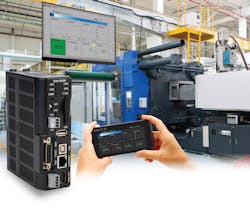Cloud connectivity, remote access and control shift OI’s view
What have been the biggest improvements to operator-interface technology in the past five years?
Bobby Thornton, product engineer for HMI and Click PLCs, AutomationDirect: In this world of the Internet of Things (IoT), Industrial Internet of Things (IIoT) and Industry 4.0, some of the biggest developments are associated with the capability to use Internet cloud connectivity and remote access/control capability for operator interface and other uses. Gaining easy, efficient and secure connectivity is an imperative for efficient operations and data collection needed to improve processes.
How has operator-interface technology benefited from remote monitoring and connectivity?
Bobby Thornton, product engineer for HMI and Click PLCs, AutomationDirect: The widespread availability of capable mobile devices means that remote access to operator interfaces has become a requirement in the industry. With remote access, there is no need for a dedicated screen, thus reducing the price of hardware. Perhaps more importantly, there is no need for an operator or engineer to travel to remote sites to change parameters or operate equipment. With the right configuration, remote operator interfaces become a troubleshooting tool allowing you to access and potentially resolve a situation before travelling to the site becomes necessary.
How do operator-interface technologies figure into digital-twin platform models being used by manufacturers?
Bobby Thornton, product engineer for HMI and Click PLCs, AutomationDirect: Operator interfaces with the capability for message queuing telemetry transport (MQTT) or its transport layer security (TLS) version, MQTTS, can gather data from the factory floor and transmit that data to the cloud, making it available for a digital-twin platform to process.
Also read: Edge-level devices with data storage improve operator interface
When will operator interfaces become IT-friendly enough that engineers are no longer required for installation and operation?
Bobby Thornton, product engineer for HMI and Click PLCs, AutomationDirect: With various technical and organizational requirements for Ethernet deployment and IP addresses/subnets, creating an operator interface that is completely IT-friendly is a stretch. However, much can be done to ensure operator interfaces are optimized for easy deployment. They can come already configured for dynamic host configuration protocol (DHCP), so setting them up on a network is as easy as plugging the human-machine interface (HMI) into any network with a DHCP server, powering it up and browsing for it using a PC running the associated software. The HMI panel will show up in the software’s browse list. Select it, and start transferring your project. No need to set IP address or subnet masks.
Also read: HMI leans into open software
What future innovations will impact the use of operator-interface technology in manufacturing operations?
Bobby Thornton, product engineer for HMI and Click PLCs, AutomationDirect: End users, systems integrators and original equipment manufacturers (OEMs) will move to use operator interfaces with:
• better security as we connect more devices to the Internet
• faster, more reliable remote access and control
• secure cloud protocols as IIoT needs expand
• powerful Web servers for browser access to operator screens and data
• reliable wireless connectivity like our current mobile devices.
Moving forward, augmented reality (AR) is the next major operator-interface jump. AR can eliminate the physical screen and touch panel. A virtual operator-interface HMI enables users to see process data and make process changes just by looking at any surface like a wall or enclosure where supplementary information is projected. The ability to look at physical process equipment and see it supplemented with virtual data representing pressures, temperatures and speeds will provide new ways for users to perform their work. Similarly, virtual reality (VR) will allow the operator to sit in a remote location and see the process as if they are standing there in person, enabling them to operate the equipment and troubleshoot issues.
Also read: Operator interface benefits from increased transparency to runtime data and system support
Tell us about your company’s state-of-the-art operator-interface technology for manufacturing.
Bobby Thornton, product engineer for HMI and Click PLCs, AutomationDirect: AutomationDirect’s C-more EA9-RHMI headless HMI operator interface is the most cost-effective HMI solution on the market. At less than $500 for the HMI, and under $1,000 for an industrial monitor, you can have a complete operator station with a 22-inch pCap touchscreen for less than $1,500. For even less money the HMI can drive any PC or HD TV/monitor. Or, if you do not need a local screen at all, put the EA9-RHMI inside an enclosure and use the remote access feature to operate the HMI from a PC. Even better, you can also use the Remote HMI app on your mobile device from anywhere to operate or check the status of your system. C-more HMIs are easy to program and easy to use but are packed with powerful features including an event manager, email, remote access capability and a built-in Web server. They offer SD and USB data log storage, as well as Ethernet, RS-232 and RS-422/485 communications. These HMIs pair perfectly with AutomationDirect PLCs, as well as other popular PLCs including Allen-Bradley ControlLogix.
About the Author
Mike Bacidore
Editor in Chief
Mike Bacidore is chief editor of Control Design and has been an integral part of the Endeavor Business Media editorial team since 2007. Previously, he was editorial director at Hughes Communications and a portfolio manager of the human resources and labor law areas at Wolters Kluwer. Bacidore holds a BA from the University of Illinois and an MBA from Lake Forest Graduate School of Management. He is an award-winning columnist, earning multiple regional and national awards from the American Society of Business Publication Editors. He may be reached at [email protected]

Leaders relevant to this article:


